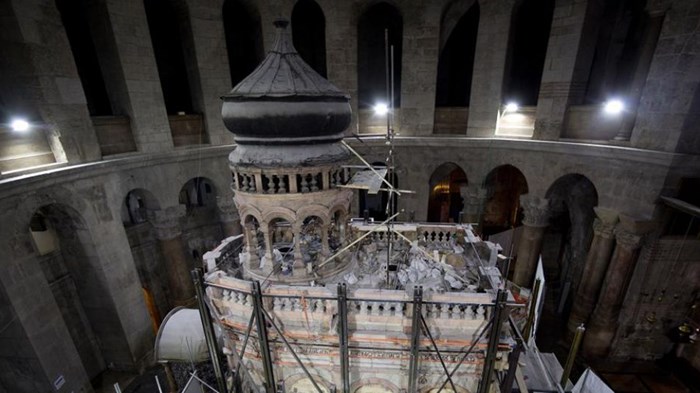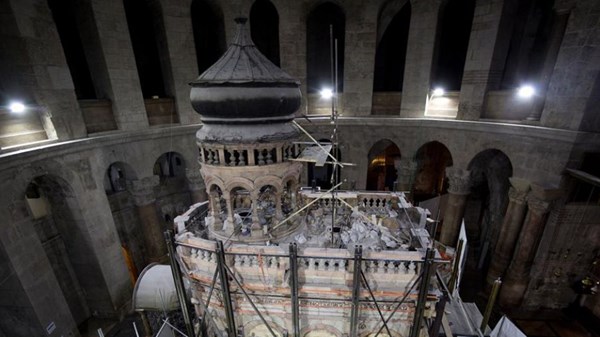

Archaeological discoveries announced in 2016 help us better understand the Bible and the biblical world, and affirm the Bible’s details about events and people.
Below are the top findings from the important excavations taking place in the lands of the Bible or that have a biblical connection. (This list is subjective, and based on news reports rather than peer-reviewed articles in scientific publications.)
10. Ancient papyrus mentions Jerusalem
What appears to be the oldest non-biblical Hebrew-language reference to Jerusalem was found on a small piece of papyrus recovered from antiquities robbers who said they had found it in a cave in the Judean desert. The inscription reads, “From the king’s maidservant, from Na’arat, jars of wine, to Jerusalem.” Dated to the seventh century B.C., the inscription was found four years ago but announced this past October. Only one other papyrus document from Israel’s First Temple Period has ever been found. However, some archaeologists and textual scholars have raised questions about the provenance of the text, and have suggested that since it was not found in a supervised excavation, it may be a forgery.
9. Ancient glass factory
Judea was known as one of the centers of glass manufacturing in the Roman world. Archaeologists excavated the remains of a glass production facility at the foot of Mt. Carmel, near Haifa, when it was discovered by workers of the Jezreel Valley Railroad Project.
8. Sunken junk from Caesarea Maritima
Old metal objects were typically melted and recycled, so a ship that sank on the way to the recycler offered a treasure trove of ancient metal objects when its cargo was discovered by scuba divers last summer. Protected by the sand on the sea bottom for 1,600 years, the mostly bronze objects include idols, lamps, and several clumps of coins.
7. Solomon's Palace at Gezer
A monumental residence built in the 10th century B.C. and excavated this past fall has been dubbed “Solomon’s Palace,” even though there’s no direct connection to the Israelite king outside of the dating, which was done through pottery remains and stratigraphic chronology. According to 1 Kings 9:16–17, the Egyptian pharaoh conquered and burned Gezer, and presented it as a dowry for his daughter’s marriage to Solomon, who then rebuilt the city.
6. Hundreds of Roman writing tablets
From the other end of the Roman Empire comes evidence for the ubiquity of writing in the first century. (Zechariah, the father of John the Baptist, used a writing tablet in Luke 1:63.) More than 400 ancient wooden tablets were excavated in London, the oldest dating to A.D. 57. The tablets were originally covered with wax and written on with a stylus. The wax is gone, but the impressions of many notes in Latin remain. They are being translated and studied.
5. Temple Mount floor designs identified
The geometric patterns of the stone tile floors of the porticos of the Jewish Temple built by King Herod have been identified from tile fragments recovered by the Temple Mount Sifting Project. Volunteers have been steadily processing tons of dirt illegally excavated from Jerusalem’s Temple Mount in 1999. Seven different tile designs have been recreated so far by Frankie Snyder, a project team member with an academic background in mathematics and Judaic studies.
4. Philistine cemetery excavation
Some of the secrets of the Philistines, the nemesis of the ancient Israelites, are expected to be revealed as archaeologists study remains excavated from a cemetery at Ashkelon. The excavations took place over the last three summers, but were revealed only in 2016. Although most of the main cities of the Philistines have been excavated, there is still a lot of important information that has eluded scholars. But that may change with the new information gleaned from these burials. “It was just a goldmine of a cemetery,” said Daniel Master, a Wheaton College professor who co-directs the excavation.
3. Stone jar factory found near Cana
Halfway between Cana and Nazareth, a cave was discovered where limestone had been mined and carved into cups, bowls, and jars, which were highly valued for their ritual purity during the first century. The cave’s proximity to Cana suggests it may have been the source of the water jars that were used for the wedding in Cana attended by Jesus and his disciples in John 2:1–11.
2. Lachish gate shrine illustrates Hezekiah’s reforms
In the ruins of a shrine excavated next to the gate of Lachish, the largest city of the kingdom of Judah after Jerusalem, archaeologists found an altar with the horns cut off from each corner. They also found a stone toilet that was never used, which had been placed in the holy of holies, apparently to desecrate it. They attributed both discoveries to the religious reforms under King Hezekiah, described in 2 Kings 18:4.
1. Unsealing the tomb of Christ
The most notable aspect of repairs that took place at the traditional tomb of Christ in October—the first look inside the tomb in the Church of the Holy Sepulchre since at least the year 1555—is that the workmen found just what they expected. The badly-in-need-of-repair marble edicule that surrounded the tomb was stripped down to the limestone platform where the body of Jesus was believed to have been laid after his crucifixion. “It appears to be visible proof that the location of the tomb has not shifted through time, something that scientists and historians have wondered for decades," said Fredrik Hiebert, National Geographic’s archaeologist-in-residence. The original limestone cave walls of the tomb were also preserved to a higher level than expected inside the edicule.
CT also compiled the Top 10 biblical archaeology finds of 2015, 2014, and 2013.
For 2016, CT has also compiled the most-read CT articles, news blogs, persecuted church stories, politics stories, cover stories, and personal testimonies.
Gordon Govier is editor of ARTIFAX magazine and host of The Book & The Spade radio program.

Support Our Work
Subscribe to CT for less than $4.25/month


















